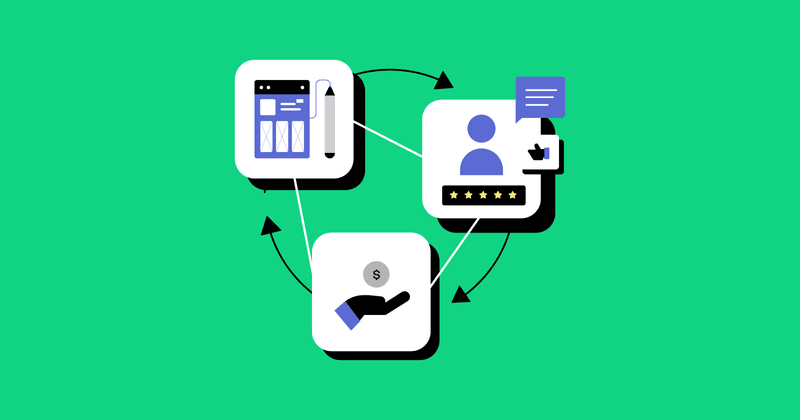The Subscription Value Loop: A framework for subscription app growth
How value creation, value delivery, and value capture form the backbone of sustainable subscription app growth.

The engine that drives sustainable growth in a consumer subscription business, says Phil Carter, is a strong core value promise that attracts users and keeps them coming back for more.
This value promise is at the heart of a framework he has developed called the Subscription Value Loop. This framework helps consumer subscription companies align their core product, growth product, and marketing teams, and convert their core value promise into more subscription revenue that can be reinvested back into the business.
Phil Carter has a diverse background, with experience in venture capital and as a product leader at billion-dollar companies like Faire, Quizlet, and Ibotta — experience he has channelled into the founding of growth advising firm, Elemental Growth. Phil also teaches a Reforge course on Consumer Subscription Growth, where he dives deeper into these topics. The next course starts on May 14th, and it’s a great opportunity for anyone looking to learn directly from him.
This blog serves as a companion piece to Phil’s own Substack blog on the framework. While Phil’s blog uses case studies to illustrate the framework, this post summarizes key ideas from his Sub Club podcast episode and points you to further reading along the way.
The genesis of the Subscription Value Loop
During his time at Quizlet, Phil and his team developed a quantitative growth model to more systematically drive user and revenue growth for the business. This model was built using about a hundred input variables that influenced Quizlet’s acquisition, retention, and monetization. It needed to be simple enough that it could be communicated across the whole company and align people around common ways of thinking about growth, and complex enough that it could help inform Quizlet�’s growth strategy and identify what the biggest leverage points were.
The Subscription Value Loop framework came about because of two main issues:
- First, there was the challenge of figuring out what the most significant bottlenecks in the business were, which informed how the growth team allocated its resources.
- Second, it helped Phil align executives around which problems should be solved by the core product team vs. the growth product team vs. the marketing team.
The framework addresses these challenges by:
- Providing a comprehensive view of growth bottlenecks, making it easier to spot where they occur in the business.
- Helping businesses to prioritize solving the most impactful bottlenecks, allowing for more efficient resource allocation.
- Clarifying the roles and responsibilities of different teams, thereby aligning them around a common goal.
The three steps of the Subscription Value Loop

The Subscription Value Loop is anchored in three steps: Value Creation, Value Delivery, and Value Capture. Each step plays a crucial role in ensuring the sustained growth and success of a consumer subscription business.
Value Creation
Value Creation, Phil emphasizes, is the cornerstone of the Subscription Value Loop. Without a product that resonates deeply with users’ needs and wants, other efforts can fall short. Value Creation is itself split into what Phil describes as the “Four Rs”.
“Value creation is the most important step, because if you don’t have a product that people really want, then nothing else matters.”
The four Rs explained:
Robust: A product must solve a real pain point, offering a strong value proposition that meets or exceeds customer expectations. The “40% test” by Sean Ellis serves as a benchmark here, indicating strong product-market fit when 40% of users would be very disappointed without the product.
Rapid: In a world flooded with apps and dwindling attention spans, value must be conveyed swiftly. The onboarding process should quickly lead users to the “Aha Moment”, ensuring they grasp the app’s value promptly.
Repeatable: Especially crucial for subscription models, the value offered must be ongoing. Users should find continuous value, preventing the decay of interest over time. This could be through regular content updates, new features, and/or insights that keep the app relevant and useful.
Revenue Generating: The product must create enough value that users will pay for it. For freemium apps, this means that premium features and/or content must be differentiated enough vs. the free product experience to convince users to subscribe.
Practical tips for optimizing Value Creation:
- Quantitatively assess product-market fit: Using tests like the “40% test” to quantitatively assess product/market fit and user engagement can guide product development and iteration.
- Segment users: Understanding which user segments are most delighted by the product can help in refining the value proposition and focusing on areas that drive satisfaction and engagement.
- Make iterative improvements: Continuous engagement with users to gather feedback and implement changes can lead to significant improvements in product/market fit and user satisfaction.
- Show, don’t tell: The onboarding process should not only inform but also engage users by demonstrating the app’s value through interactive experiences.
Value Delivery
Value Delivery in the Subscription Value Loop is about efficiently connecting users with the product’s value. As Phil points out, it’s not just about having a desirable product — it’s about getting it into users’ hands in the most cost-effective way possible. Value Delivery has become increasingly crucial due to the crowded app market, the challenges posed by App Tracking Transparency (ATT) and iOS 14 making paid marketing less efficient, and the changing landscape of venture capital funding.
The reason this is so important for consumer subscription apps is because the playbook for much of the last decade has been find a product that people are interested in, and then go spend a bunch of money on Google and Meta to acquire users and make sure LTV/CAC is high enough for the business to work and keep your fingers crossed that lasts. I’m oversimplifying it. But that playbook is far less efficient than it used to be.
Practical tips for enhancing Value Delivery:
- Focus on organic growth: Develop a strong organic acquisition strategy that aligns with your product and market. This could involve optimizing for SEO, encouraging user-generated content, or creating shareable content that naturally draws users to your app. More on these below.
- Word of mouth and content: Two primary categories of organic growth strategies include word of mouth and content-based approaches. Word of mouth grows through the product’s inherent value and users’ willingness to share their positive experiences. Content strategies capitalize on company-generated and/or user-generated content to power SEO, which can lead to growth through organic search.
- Monitor LTV/CAC and Payback Period Keep a close eye on the lifetime value (LTV) of your users versus the customer acquisition cost (CAC). Aim for a sustainable model where organic growth supports a healthy LTV/CAC ratio. Also measure how much time it takes to payback the initial cost of acquiring subscribers – the best consumer subscription apps have payback periods of <1 month.
- Adapt to market changes: Stay responsive to changes in the market, such as shifts in user behavior or platform policies, and adjust your Value Delivery strategies accordingly.
Value Capture
Value Capture is the process of ensuring that your app’s subscription revenue, the essential fuel for your business, is optimized to sustain and propel growth. It’s about finding the right balance between offering immense value to users and ensuring the business captures enough of this value that it can reinvest subscription revenue into supporting growth.
The “Five Ps” of Value Capture:
Pricing and packaging:
- Utilize tools like the Van Westendorp Price Sensitivity Meter and Conjoint Analysis to determine optimal pricing structures and understand the value users place on various features.
- Consider segmenting pricing based on user demographics, usage patterns, or geographic locations to align with their willingness to pay.
Paywall strategy:
- Crafting an effective paywall is crucial. You should introduce your paywall early in the user experience, but design it thoughtfully to avoid overwhelming new users.
- Tailoring the paywall experience based on user behavior or entry points can significantly enhance conversion rates.
📚 Learn more: Read our guide to paywall location optimization.
Payments:
- Consider supporting Alternative Payment Methods (APMs) like Paypal, Amazon Pay, Apple Pay, and Google Pay, as well as regional-specific APMs that are important in certain international markets. This helps reduce friction, increasing subscriber conversion and reducing involuntary subscriber churn.
- Ensure the subscription, trial, and cancellation processes are transparent and user-friendly to maintain trust and reduce churn.
Promotions:
- Use targeted promotions to align the product’s value with the user’s willingness to pay, capturing a broader range of consumers.
- Activity-based discounts and geography-based pricing provide additional ways to flex your price based on each individual user’s willingness and ability to pay for your product
Practical tips for enhancing Value Capture:
- Reinvestment: Channel a significant portion of the captured value back into product development and paid user acquisition campaigns.
- Flexibility in pricing: Adopt flexible pricing strategies that cater to different segments of your user base, enhancing overall value capture.
- User-centric promotions: Design promotions that not only attract users but also feel personalized and valuable, thereby increasing conversion and retention.
Summarizing the Subscription Value Loop
Phil Carter’s Subscription Value Loop is a strategic framework that helps you take a holistic approach to nurturing and scaling a subscription app. By delving into the intricacies of Value Creation, Value Delivery, and Value Capture, we’ve uncovered the symbiotic relationship between these elements that drive sustainable growth.
Recap of the framework:
- Value Creation hinges on developing a product that not only meets but exceeds user expectations. The best consumer subscription products create value that is Robust, Rapid, Repeatable, and Revenue Generating.
- Value Delivery emphasizes the importance of efficiently connecting your valuable product with users, leaning heavily on organic growth strategies to supplement paid user acquisition (which has become less efficient since Apple launched ATT with iOS 14.5).
- Value Capture focuses on maximizing subscription revenue by optimizing Pricing, Packaging, Paywalls, Payments, and Promotions, all of which can be used to remove friction and align the value your product delivers with each individual user’s willingness and ability to pay.
Catch Phil on the Sub Club podcast, where he talks with David and Jacob about the framework and more:
You might also like
- Blog post
Modeling attribution on iOS: what works, what doesn’t, and how to choose
How to navigate the messy world of SKAN, AEM, and probabilistic attribution — plus two practical frameworks to get a clearer picture of campaign performance.
- Blog post
Your sprints must pay for themselves: Dan Layfield’s product advice
What’s worth building? Dan Layfield shares a 3-bucket framework to help app teams prioritize features, fix churn, and ship faster.
- Blog post
Is monetization hurting your app’s user experience?
Don’t trade short-term revenue for long-term trust. How ethical UX can still drive effective monetization.

